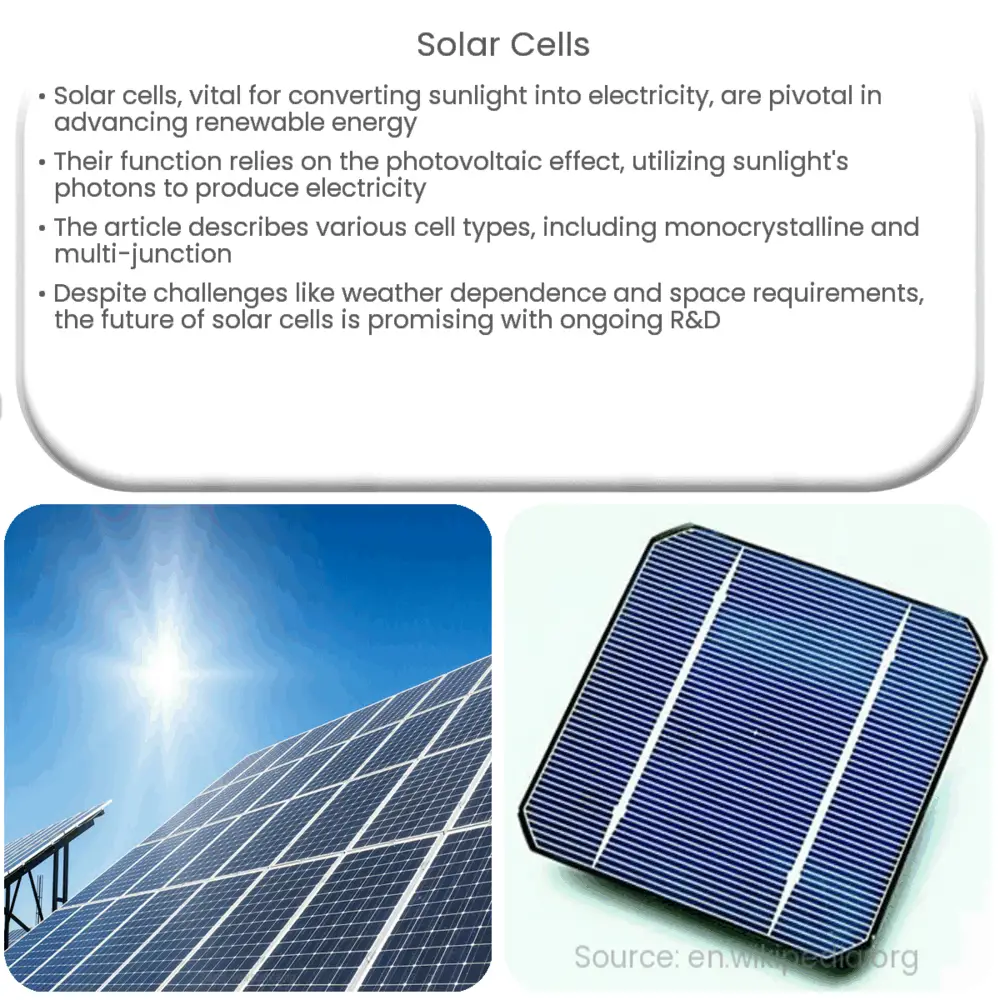Explore the world of solar cells – understand their working principles, types, advantages, challenges, and future prospects in renewable energy.

Understanding Solar Cells: Harnessing the Sun’s Energy
Solar cells, also known as photovoltaic (PV) cells, are the critical components that convert sunlight into electricity. They are a key pillar of renewable energy solutions and are steadily gaining popularity as we shift towards sustainable energy practices. This article delves into the intriguing world of solar cells, explaining their working principles, types, advantages, and potential challenges.
Principles of Operation
A solar cell functions based on the photovoltaic effect, a physical and chemical phenomenon discovered in the 19th century. The process begins when sunlight, composed of tiny packets of energy called photons, strikes the solar cell. These photons carry enough energy to dislodge electrons from atoms, a process known as ionization. The dislodged electrons are then captured and channeled to produce a flow of electricity.
Types of Solar Cells
- Monocrystalline Solar Cells: These are made of a single crystal structure, which allows electrons to flow more freely, resulting in higher efficiency. They are recognizable by their uniform, dark appearance and rounded edges.
- Polycrystalline Solar Cells: Unlike monocrystalline cells, these are composed of multiple crystal structures. They have a blueish hue and are slightly less efficient due to the presence of boundaries that can impede electron flow.
- Thin-Film Solar Cells: These cells are made by placing one or more thin layers of photovoltaic material onto a substrate. They are less efficient but can be cheaper and more flexible, opening up new applications.
- Multi-Junction Solar Cells: These cells use multiple semiconductor materials to capture a broader spectrum of sunlight, thereby achieving very high efficiencies. They are commonly used in space applications.
Advantages of Solar Cells
Solar cells present numerous advantages, a key one being their ability to generate clean, renewable energy. This reduces reliance on fossil fuels, subsequently reducing greenhouse gas emissions. Additionally, solar cells are relatively low maintenance and can provide energy independence to homeowners, especially in regions with ample sunlight.
Despite the many advantages, there are some challenges associated with solar cell technology, such as…
Challenges with Solar Cells
While solar cells present numerous advantages, they do come with some challenges. Firstly, their efficiency can be significantly affected by weather conditions; they are less effective on cloudy or rainy days. Secondly, solar panels require a substantial amount of space for installation, which can be a limiting factor in densely populated areas or areas with high land costs.
Furthermore, there are environmental concerns associated with the life cycle of solar panels. While they produce clean energy during their operational life, the production process of solar panels involves the use of hazardous materials, and end-of-life disposal can present environmental challenges.
Future of Solar Cells
Despite these challenges, the future of solar cells looks promising. Research and development efforts are consistently improving the efficiency, cost-effectiveness, and sustainability of solar cell technology. Emerging technologies, such as perovskite solar cells and organic photovoltaics, promise higher efficiencies and potentially lower environmental impact.
Simultaneously, efforts are underway to improve energy storage solutions, which would mitigate the issue of solar energy intermittency. These include advancements in battery technologies and innovative solutions such as solar-to-hydrogen conversion.
Conclusion
In conclusion, solar cells play a pivotal role in the global transition towards renewable energy. Despite their challenges, their ability to convert sunlight directly into electricity provides an invaluable solution to our growing energy needs. As research advances, we can expect to see more efficient, affordable, and sustainable solar cell technologies emerging, making solar power an increasingly attractive option for a sustainable future. As individuals and communities, embracing and investing in solar technology can contribute significantly to mitigating the impacts of climate change and fostering energy independence.

